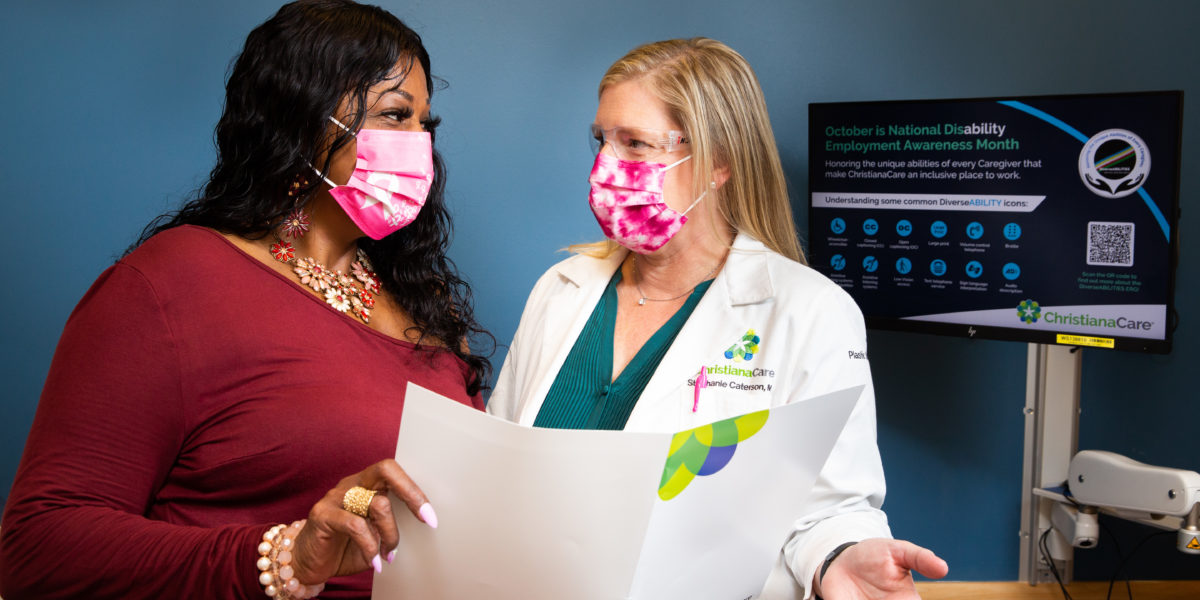If your doctor has recommended a mastectomy or an extensive lumpectomy, now is the time to consider breast reconstruction. Even if you’re not sure that breast reconstruction is right for you, it’s important to know your options.
Click here for more on ChristianaCare’s Center for Breast Reconstruction or call 302-623-3605 to make an appointment.
A plastic surgeon can start the surgery right after the cancer surgeon has removed the tumor or the plastic surgeon can perform the breast reconstruction after you’ve healed from your cancer treatment.
Today, many techniques can lead to positive results, whether you want to have the reconstruction immediately or later. If you decide against reconstruction after a mastectomy, ask your plastic surgeon about procedures that will help you feel more comfortable after surgery, such as a breast reduction on the healthy breast.
What is breast reconstruction?
During breast reconstruction, a specialized plastic surgeon rebuilds the breast. Your plastic surgeon can reconstruct the breast mound, perform symmetry surgery to help make the breasts match, recreate nipples and perform 3D nipple and areola tattooing. The complete breast reconstruction process usually requires several procedures, spaced out to ensure healing.
What are the different types of reconstruction?
ChristianaCare is the only center in Delaware performing microsurgical flap breast reconstruction.
- Breast implants, either silicone or saline.
- Flap reconstruction, which involves using tissue from another area, such as the abdomen, back, thigh or buttock to make the breast shape.
- A combination of both techniques, using some of your body’s tissue plus an implant.
Why would I choose one type of reconstruction over the other?
During your consultation, your plastic surgeon will discuss with you the factors that will help you choose a reconstruction technique. These factors include:
- Your cancer treatment. If you need chemotherapy or radiation after your mastectomy, your breast reconstruction process may need to be altered to accommodate the healing process. Radiation will affect the entire chest area. That’s why definitive breast reconstruction must wait at least six months after you’ve completed radiation. Your surgeon may recommend a temporary implant at the time of mastectomy to serve as a space-saver for future flap reconstruction. Or if your tissue has recovered well, you may elect to stay with the implant.
- Your overall health. If you smoke or have other health conditions, your doctor can recommend the best protocol. Active smoking is a contraindication for elective surgery. Medical conditions, such as diabetes and steroid use, can affect the ability to heal.
- Your lifestyle. In the past, tissue flaps could affect muscle function and range of motion, which could pose a problem for athletic, active people. New muscle-sparing techniques prevent this loss. The surgeon must have specialized training in these advanced procedures.
- Your body. You may be too slender for a tissue flap or lack enough excess soft tissue (fat) in the areas used for breast reconstruction.
Will reconstruction put me at a higher risk for cancer?
Multiple studies have shown that breast reconstruction is safe and effective. Having reconstruction will not change your chance of getting breast cancer again in the future. It is rare for breast reconstruction to mask a breast cancer recurrence.
What about my remaining breast? Will my breasts match?
Depending on the results you desire, your plastic surgeon may recommend surgery on the other breast to reduce, enlarge or lift it. This will help with improving symmetry. Women with large breasts may use this opportunity to have a breast reduction if they wish. Others may want an enhancement. Your plastic surgeon will help you understand what to expect for long-term results.
What about a nipple?
ChristianaCare offers 3D tattooing to create a natural-looking nipple and areola. Call for more information.
There are significant advances in this area. Skilled surgeons can make small incisions and wrap the skin to create a nipple bump. This is usually followed by tattooing the new nipple and areola area for natural pigmentation. However, if your other (natural) breast does not have a prominent nipple, you can choose 3D tattooing alone to create a natural-looking nipple and areola. We have a provider specially trained in this state-of-the-art tattooing technique.
Will my reconstructed breast feel like the other one?
The majority of nerves to the breast skin are typically removed with the mastectomy. Skin sensation may return slowly to the breast skin as the nerves regrow from the edges. This process may take months or years.
When you touch your reconstructed breast, the breast mound should feel soft. Implants may be slightly cooler and more firm than natural flap reconstructions, which are usually warm and soft.
Your breast reconstruction surgeon will make every attempt to minimize the visible scars on the breast, which will help with sensation.
How long will my reconstruction last?
For many people, breast reconstruction has positive, lifelong result. Over time, your body may mature, causing natural changes in the breast area. You may choose to have a small adjustment surgery if this occurs. Additionally, implants may succumb to wear and tear, requiring an exchange surgery.



